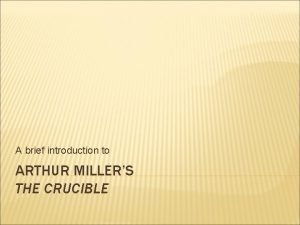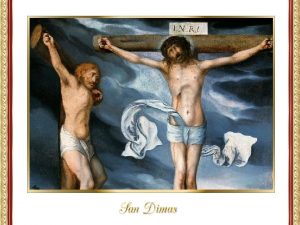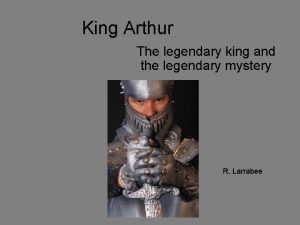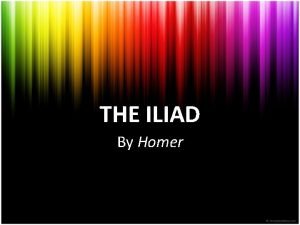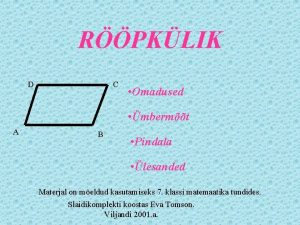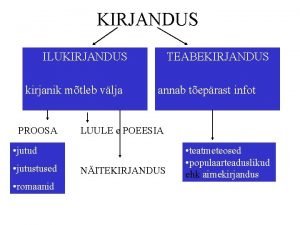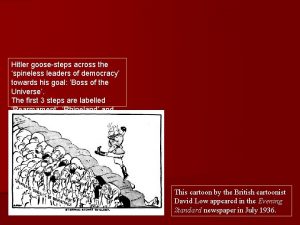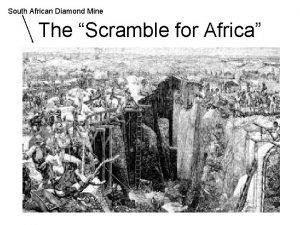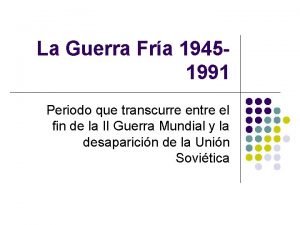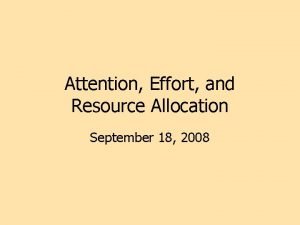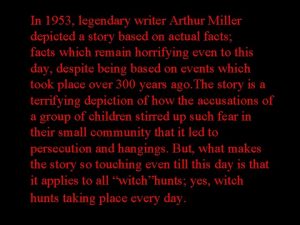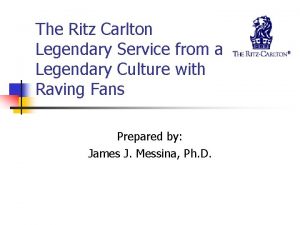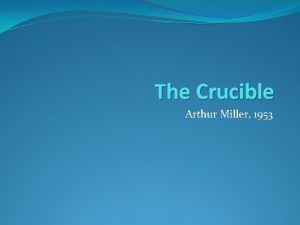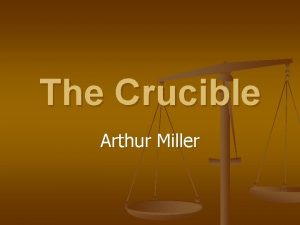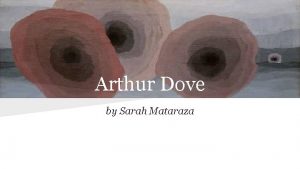t In 1953 legendary writer Arthur Mille depicted





































- Slides: 37

t In 1953, legendary writer Arthur Mille depicted a story based on actual facts; facts which remain horrifying even to day, despite being based on events wh took place over 300 years ago. The sto terrifying depiction of how the accusations of a group of children stirred up such fea their small community that it led to persecution and hangings. But, what m the story so touching even till this day it applies to all “witch”hunts; yes, witc hunts taking place every day.

Ladies and Gentlemen Welcome to the story of:

It is the spring of 1692. The small town of Sale had been established a mere forty years earlier yet to make it its mark on the rest of the world. while not all were immediately aware, 1692 wo of ‘revolution’ in America. No longer was ever to adhere to the strict lifestyle that had been se their forefathers. While the town of Salem may appeared to be a serene and enjoyable place to about to experience an event that would chang forever. Little did they know, though, that their would still have a tremendous effect on us toda Meet the people

The one, the only: John Proctor

The Crucible Court What did they see?

Abigail

Tituba

Elizabeth Proctor

John and Elizabeth

What Happened in REAL HISTORY? Analogy: The snowball effect

Salem—the Village History • 1620: The Mayflower lands at Plymouth Rock. • 1630: John Winthrop is elected the first governor. • 1641: English law makes witchcraft a capital crime. • November, 1689: Samuel Parris is named the new minister of Salem, and Salem Village Church is formed.

The Year-1692 • January • Parris’ daughter, Betty (9), and niece, Abigail Williams (11) begin acting strangely and babbling incoherently. The village physician documents their ailments as hysteria. • Hysteria is characterized as having severe fits and seizures.

The “Black Magic” Remedy • February 25, 1692: • Parris’ Caribbean Indian slaves, Tituba and John Indian, bake a “witch cake” with the girls’ urine to feed to the village dog. • Tituba, at the request of neighbor Mary Sibley, bakes the "witch cake" and feeds it to a dog. • According to English folk remedy, feeding a dog this kind of cake, which contained the urine of the afflicted, would counteract the spell put on Elizabeth and Abigail. • The reason the cake is fed to a dog is because the dog is believed a "familiar" of the Devil.

The Court’s Remedy • Early March: • Samuel Parris files a complaint to the governor for a court to be issued. The colony operated in selfgovernment until the end of 1693. • Preliminary Arrests • February 29, 1692: Arrest warrants are issued for Tituba, Sarah Good and Sarah Osborne. – Pressured to identify the source of their affliction, the girls named three women, including Tituba, Parris' Carib Indian slave, as witches. On February 29, warrants were issued for the arrests of Tituba, Sarah Good and Sarah Osborne. – Although Osborne and Good maintained innocence, Tituba confessed to seeing the devil who appeared to her "sometimes like a hog and sometimes like a great dog". What's more, Tituba testified that there was a conspiracy of witches at work in Salem.

The First 3 Accused • Tituba – Carab Indian from Barbados, Parris’ slave, married to John Indian, also a slave – practice of Voodoo • Sarah Good – beggar • Sarah Osborne – married her indentured servant & rarely attended church

The Investigations • March 1, 1692: • Magistrates John Hathorne and Jonathan Corwin: – physically examine Tituba, Sarah Good, and Sarah Osborne for "witch’s teats. " • “Witches teats” are imperfections on the bodies of afflicted or possessed persons. • George Beard’s description of medical instruments used include: “examination with pins, all over the body, in order to detect the shriveled, callous and non-sensitive places, which were supposed to be diagnostic signs of bewitchment. [1]”

The “Fingers of God” Abigail Williams, Betty Parris, Ann Putnam, Jr. , Sarah Bibber, Elizabeth Booth, Sarah Churchill, Elizabeth Hubbard, Mercy Lewis, Sussana Sheldon, Mary Warren, and Mary Walcott Ann Putnam, Jr. • Becoming afflicted shortly after Williams and Parris, Putnam(13) was one of the most active accusers during the trials. She claimed to have been afflicted by 62 different people, and testified in many trials. Some believe the continuance of the trials was due to the attention given to the accusers, which was unheard of in Puritan times. • In 1706, Ann Putnam Jr. was the only girl to offer an apology for her part in the witch trials. Some historians have speculated that her parents, Thomas and Ann (Carr), Sr. , coerced Putnam to accuse those they were feuding with or sought revenge on. Many of the accused had some sort of relationship with the powerful Putnam family. • When her parents died in 1699, Putnam was left to raise her nine siblings aged 7 months to 16 years. She never married, and died in 1716.

Indictments: Rebecca Nurse and Martha Corey • March 21, 1692: Magistrates Hathorne and Corwin examine Martha Corey. She is sent to prison. • They accuse 71 -yearold Rebecca Nurse of bewitching them. Rebecca Nurse is the area nurse; she attended Parris’ daughter bedside early in 1692. • Photograph courtesy of: http: //www. iath. virgini a. edu/salem/people/n ursepics. html

Dorothy Good- a juvenile case • March 23, 1692: • Marshal Deputy Samuel Bradbrook arrests 4 -year-old Dorcas(Dorothy) Good because of physical impairments. • The arrest questioned the imprisonment of the mentally and physically disabled. • Many of those accused of witchery awaited their fates inside small prison cells, approximately 6 by 4 feet. • http: //www. geocities. c om/laughtershock/sal em. html

Mitigation to a new court • May 14, 1692: • Sir William Phipps, the newly elected governor of the colony, arrives from England with a new provincial charter. • The charter rescinds the 1684 prohibition of self-governance within the colony.

The Testimonials’ Backlash • June 11: Arrests and examinations continue; Accused in neighboring communities of Andover, Ipswich, Gloucester, are tried and hanged on heretical charges. • In Salem: • Twenty-three suspected Salem witches are in jail. • These include John and Elizabeth Proctor, Bridget Bishop, and Giles Corey. • Bridget Bishop is the first to be hanged on Gallows Hill. Bridget Bishop"I am no witch. I am innocent. I know nothing of it. "

An Early Form of Due Process • June 10: Nathaniel Saltonstall resigns and Phipps advises caution in the witchcraft proceedings but also “speed and vigour. ” • Many of the actions in Salem, Mass. are precedent cases for the framers of the constitution in the 1700 s.

Right to Petition • July 23, 1692. Several convicted “witches” write petitions to the magistrates for release. • John Proctor writes of about the atrocities that led to their confessions. • An excerpt reads, • “My son, William Proctor, when he was examined, because he would not confess that he was guilty, when he was innocent, they tied him neck and heels till the blood gushed out of his nose, and would have kept him so 24 hours. ”

John Proctor at his confession • “Because it is my name! Because I cannot have another in my life! (…) How may I live without my name? I have given you my soul; leave me my name!” • ~John Proctor in Miller’s Crucible ~taken from www. dd-l. net/ Puritan’s often believed in a “good name, ” as an endeavor of a good Christian life.

Testimony of Confessions • Some of those admitted that they were in league with the devil; that they had signed the devil’s book. • “These confessions, were mostly insincere, and were wrung and pressed out of the victims in order that they might save their lives. ” ~George Beard

The sentences are carried out. • August 19: George Burroughs, John Proctor, John Willard, George Jacobs, and Martha Carrier are hanged. Elizabeth Proctor is spared because she is pregnant. • September 9: Six more tried and sentenced to death, including Martha Corey.

21 st century question: Can citizens refuse trial? • September 17: Nine more are tried and sentenced to death. Giles Corey refuses to stand trial. • September 19: Corey is pressed to death. This tortuous and inhuman punishment involves a stone to be placed on the chest of a man. As a result, the stone crushes a man’s heart and cavity.

Giles Corey’s death • • Giles Corey refused to give testimony at the 1692 Witch Trials. He would neither confess nor deny the charges brought upon him. So, in order to obtain a statement, he was taken outside, a board placed across his body, and heavy stones piled on top. It is said that his only words before he was crushed to death were: "More weight!" Web excerpt from: http: //www. geocities. co m/laughtershock/salem. html (left-bottom) a mysterious light illuminates Corey’s grave marker

Accusations of Public Officials • October 3: • • Increase Mather delivers a sermon called “Cases of Conscience Concerning Evil Spirits Impersonating Men. ” The speech casts serious doubt on the validity of spectral evidence—the girl’s ghoulish visions—and says, “It were better that ten suspected witches could escape, than that one innocent person should be condemned. ” • Lady Phipps is the object of the speech.

The trials end…in 1693 • January 1693: 49 of the 52 surviving people brought into court on witchcraft charges are released because their arrests were based on spectral evidence. • April 25: The court sits in Boston. None found guilty. • May: Sir William Phipps orders the release of all accused witches remaining in jail, on payment of their fees. • A total of 19 townspeople are hanged; 156 imprisoned (numbers vary).

Before Public Hangings

Conclusion • 1697: Samuel Parris is ousted from Salem Village Church and leaves the village. • Proctor’s petition before death: The innocency of our case with the enmity of our accusers and our judges and jury, whom nothing but our innocent blood will serve their turn, having condemned us already before our trials…makes us bold to beg and implore favourable assistance of this our humble petition to his Excellency, that if it be possible our innocent blood may be spared. ” ~The Salem Witch Trial: Reader

The Hanged Bridget Bishop George Burroughs Martha Carrier Corey Mary Easty Good Elizabeth Howe George Jacobs, Sr. Susannah Martin Rebecca Nurse Alice Parker John Proctor Pudeator Wilmott Redd Margaret Scott Samuel Wardwell Wildes John Willard Martha Sarah Mary Ann Sarah

How Could This Happen? Possible Explanations • Actual Hysteria • Psychological hysteria due to Indian attacks • Prejudices • Outcasts, differences • Old Scores • Land • Cooincidences • Placing Blame • Ergot poisoning? • bird-borne encephalitis lethargica (double vision, sleep-like comas) Ergot fungus growing on a stalk of wheat

Arthur Miller’s Crucible • Many scholars associate the Salem witch trials with Miller’s play. • Here, you can listen to Lincoln Center’s interpretation of Arthur Miller’s 1953 play: http: //town. hall. org/Archives/ra dio/IMS/Harper Audio/5356_ha rp_00_ITH. html

But, what really makes The Crucible so even to this day, is that the story applies events that we witness right before our o Yes, we have allowed ‘witch hunts’ to c take place, proving that we have yet to c mistakes that were made over 300 years

In our day. . . The End
 Arthur millers drama fra 1953
Arthur millers drama fra 1953 Buen ladrón eve and lucius (legendary)
Buen ladrón eve and lucius (legendary) Kyle petty 1990
Kyle petty 1990 Buru (legendary creature)
Buru (legendary creature) The legendary king
The legendary king Who is homer
Who is homer Cis 1020
Cis 1020 Erpice anno mille
Erpice anno mille Prisma sp
Prisma sp Mille win
Mille win Mille pattes mandelieu
Mille pattes mandelieu Comment recomposer un nombre
Comment recomposer un nombre Millegpg
Millegpg Mille lacs tribal police department
Mille lacs tribal police department Mappa concettuale spedizione dei mille
Mappa concettuale spedizione dei mille Vanad mäestikud
Vanad mäestikud Napptigu
Napptigu Mille feuilles online
Mille feuilles online Dc ab
Dc ab Teabekirjandus
Teabekirjandus Of what value is the weather depiction chart to the pilot?
Of what value is the weather depiction chart to the pilot? Karikatur spineless leaders of democracy
Karikatur spineless leaders of democracy What wind is forecast for stl at 12 000 feet
What wind is forecast for stl at 12 000 feet Who is depicted
Who is depicted Nasser and prokofiev 1953
Nasser and prokofiev 1953 Cherry 1953 dichotic listening
Cherry 1953 dichotic listening Modal model of memory
Modal model of memory 2007-1953
2007-1953 Cherry 1953 dichotic listening
Cherry 1953 dichotic listening July 26 1953
July 26 1953 What are the defects of existing curriculum
What are the defects of existing curriculum Fhrer
Fhrer La maxima tension 1947 y 1953
La maxima tension 1947 y 1953 Alignment with west 1953-62
Alignment with west 1953-62 Fahrenheit 451 1953
Fahrenheit 451 1953 The crucible 1953
The crucible 1953 1953
1953 Wickens
Wickens
